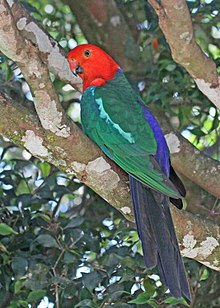Australian King Parrot

Description
The Australian king parrot (Alisterus scapularis) is endemic to eastern Australia ranging from Cooktown in Queensland through to Port Campbell in Victoria. Found in humid and heavily forested upland regions of the eastern portion of the continent, including eucalyptus wooded areas in and directly adjacent to subtropical and temperate rainforest. They feed on fruits and seeds gathered from trees or on the ground.
Adults of both sexes are about 43 cm (17 in) in length, including the long, broad tail. The adult male has a red head, breast, and lower undersides, with a blue band on the back of the neck between the red above and green on the back, the wings are green and each has a pale green shoulder band, the tail is green, and the rump is blue. The male has a reddish-orange upper mandible with a black tip, a black lower mandible with an orange base, and yellow irises. The plumage of the female is very different from the male having a green head and breast, a grey beak, and the pale shoulder band is small or absent. Juveniles of both sexes have brown irises and a yellowish beak, and otherwise resemble the female.
The two subspecies are A. s. minor, found at the northern limit of the species range and is similar in appearance to the nominate subspecies but smaller, typically about 5 cm (2 in) smaller in length.
On those rare individuals which have areas without melanin, feathers are orange to yellow. Such a bird can look startingly different from the more common scarlet and green variety.
Scientific Name
Alisterus scapularis
Country Of Origin
Eastern Australia
Size
16 to 17 inches
Life Expectancy
25 years
Noise Level
Quiet
Talk / Trick Ability
Good
Characteristics
Females are mostly green with some blue on their rumps, with red on their lower bodies. Adult males have bright plumage, with a red head and chest, bright green back and tail, and bright blue under wings. While Australian king parrots do not tend to be cuddlers, they do enjoy socialization with their flock and/or human families and, when hand-reared, can learn to mimic the language of their owners. However, those who keep them as pets note that socialization can be challenging and it requires time and patience to gain this bird’s trust. They are in demand for aviary settings because of their bright colors and quiet dispositions and their reputation for getting along well, with smaller birds. Australian king parrots are among the least noisy and least destructive parrots.
Behavior / Health Concerns
Australian king parrots are not readily available as pets in most areas, but when they are kept as pets, they are generally gentle, can entertain themselves and are much quieter than many other parrot species. Because these birds are large and have long tails, they require a large amount of space in which to live and play comfortably. This species tends not to prefer being handled, so accustoming the bird to a human’s touch should begin at a very young age. They can bond to people and can make devoted pets. They do well in an aviary setting, too.